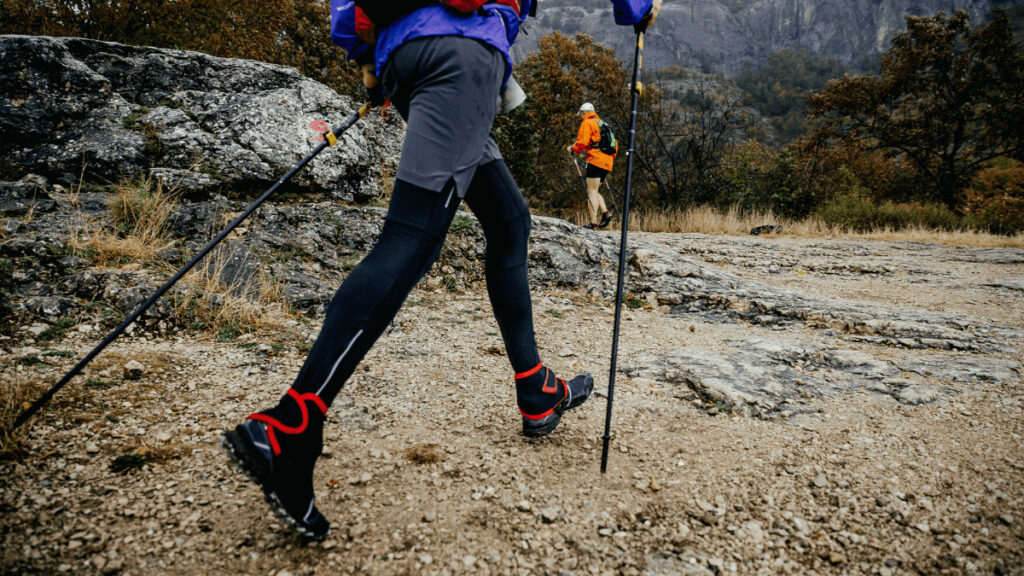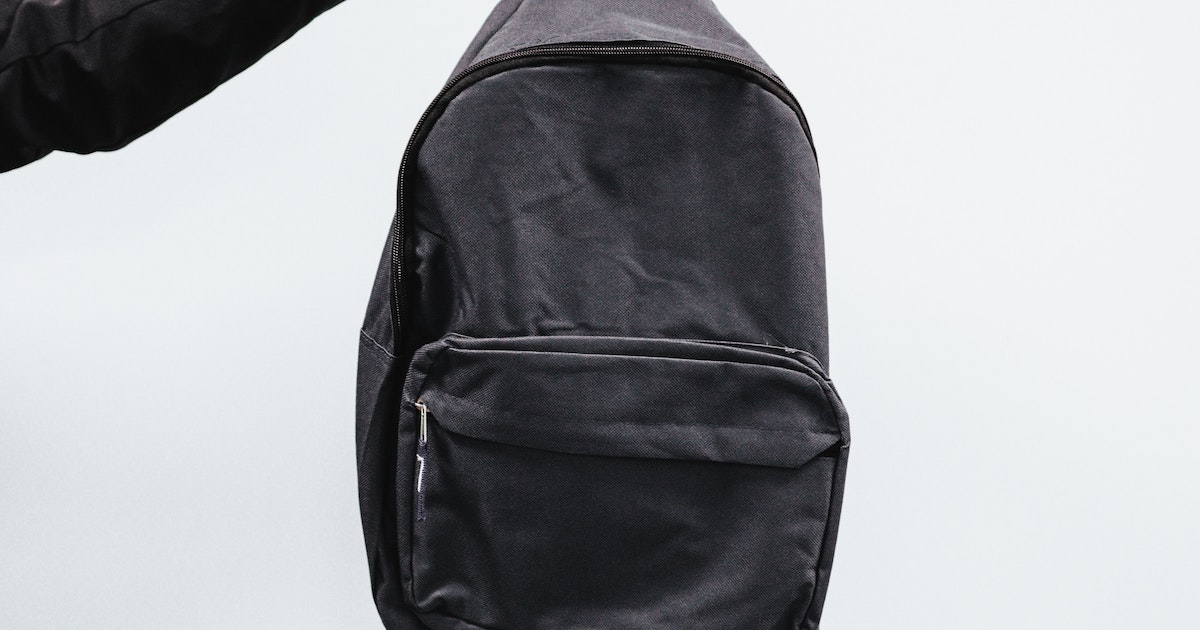Trekking poles are handy for various tasks while traveling with the finest travel backpack, including crossing rivers, determining the level of mud, and clearing damp plants off the trail. Some individuals place a high level of faith in them since they can support and balance a large rucksack.
If you collapse when wearing snowshoes, they will act as your right-hand man until you are recovered. While not in use, the trekking poles can become a nuisance.
Providing your trekking poles are folding and have the ability to be extended to a manageable length, you may store them in your bag.
However, those who bring old ski poles or any other trekking poles that cannot be folded into a bundle will have to carry them for the duration of the journey.
Trekking poles may be attached to most backpacks using dedicated attachment points. See how to connect your trekking poles to your backpack in a variety of different ways in this video.
See Also: 6 Best Basketball Backpacks in 2022: A Detailed Buying Guide
Table of Contents
What Are the Best Ways to Pack Your Trekking Poles?
If you’re going on a hiking vacation and you’d like a little assistance crossing difficult terrain, you might want to bring your trekking poles along with you.

Trekking poles make it much simpler to maintain your balance when trekking, and they also offset the weight of your backpack, which relieves some of the pain on your back.
Packing trekking poles, though, might be a complex task if you’ve never done it before, as most experienced hikers will tell you.
The good news is that there are a variety of choices for storing your hiking poles on the trails, as well as a straightforward method of packing poles for travel.
1. Pack them Inside Your Backpack
This is the most stable and safest method when packing your trekking poles. Because they are collapsible, you will be able to fit them inside your backpack.
Please put them in the bottom of your backpack and utilize clothing items such as coats and thermal protection to cushion them while you’re traveling.
You should be aware that most airlines do not allow trekking poles to be transported in cabin luggage if you are traveling by airplane. Make sure to keep this in mind when you’re packing.
It is recommended that you check them in with your other luggage. If you are checking your belongings in, don’t forget to attach a delicate tag to your backpack.
2. Having connection hooks on the backpack
Occasionally, the connection hooks for your trekking poles are included with your backpacks, allowing you to seal the loop on your poles.
A few backpacks contain quick-release connectors that open and close rapidly, as well as a little hook to finish the look. If your backpack is of this type, you will need to unhook the knot and insert the trekking pole into the bag before continuing.
Step 1: Place it so that the handles of your bag are pointing upwards toward the top of your backpack.
Step 2: Close the trekking pole with the knot you made before.
Step 3: Attach the lowest loop of your backpack to the section of the trekking pole attached to it. Using this method, you will be less likely to lose control of your trekking pole.
Step 4: To determine if your pole will stay in that loop or not, push the pole more toward the bottom of your rucksack.
Step 5: Now, remove the strap off your bag and tighten it across the pole as much as you can. It will assist you in maintaining control of the pole and make your travel more pleasant.
Step 6: Connect the other pole to your bag in the same manner, and you’ll have everything you need to keep your hands free while you’re out walking.
3. Loop them and fasten them with straps.
The majority of backpacks are equipped with loops on the sides. Passing your trekking sticks through them and securing them is something you may do with them.
Pass them through the loops on the compression straps and tighten them up. Keeping your poles in this position will prevent them from dropping even if your bag is kept straight.
4. Attach the poles with compression straps
This will also assist you in attaching the trekking pole to your backpack if you have a bag that does not have side pockets but does have compression straps.
These straps can be found in a variety of locations on your pack. The fact that they are attached to the sides of your bag is not required.
Depending on your bag, you may have some snaps that allow you to attach your compression straps in various positions throughout the backpack. So look for those images as well.
A trekking pole that cannot be reduced to a manageable size might also benefit from this technique of transportation. You must attach your poles to compression straps to complete the task.
Step 1: Remove the compression straps from your clothing.
Step 2: The trekking pole should be threaded through these straps.
Step 3: Tie the straps around the poles at this point.
Step 4: You can protect your poles from toppling overusing this device. This method is only effective when the trekking poles are equipped with a basket. Trekking poles may or may not come with a basket.
5. Using a side pocket to connect a trekking pole
If your backpack does not have any straps and does not have a bottom hook to hold your trekking pole in place, but it does have side compartments and solid straps, it is the ideal choice.
- Simply slipping the trekking pole handle into the side pocket of your backpack is all that is required.
- Wrap the compression straps over your trekking pole and secure them in place.
- Fix them firmly in place.
6. Trekking poles may be attached to the backpack’s top
The poles can be secured in the backpack using a different method if your backpack does not include compression straps, pockets, or any other attachment points.
The option is to set the trekking poles on top of your backpack and secure them in place with a strong knot. You may utilize this strategy even if you have a much larger bag than usual.
- Place the trekking poles on top of the major pockets of your bag to keep them out of the way.
- Close the top of your bag and secure the poles in their respective positions.
- The strategy is only applicable if you are hiking in an open area with no obstacles in your way. There will be a small crossbar across your back if you don’t take care.
If, by chance, your backpack does not have a top that can be tied down or does not have any straps on the top, read on. There is just one choice available for you to choose from. You may attach the trekking pole to the real body of your backpack using velcro or other adhesive.
- Please place them in such a manner that their handles are pointing downwards after you are finished.
- Open and close the backpack by zipping it open from the other side.
- The top of the backpack should have the tips of the poles protruding from the sides.
- When turning around, be cautious as it may cause damage to your buddy’s sight.
7- Additional packing pole recommendations:
- If you travel with your trekking poles in a different bag, you have a higher chance of losing them while traveling. You should make sure that they are packed with the rest of your luggage, whether you’re traveling by car, rail, or plane. A lost pole is something you don’t want to happen to you before you even set foot in the mountains.
- They are not permitted in cabin luggage on most carriers. So be sure you check it in with your backpack when you arrive. It is most secure to store them in your bag for this purpose.
- If you are traveling by train, keep them safely tucked away inside your backpack to avoid them being destroyed or stolen while you are traveling.
Things you should avoid when attaching your pole to the backpack:
Some people attempt the following procedures but cannot properly secure the trekking poles to their bags. You must stay away from them.
- Do not connect them to your backpack separately from your other belongings. There is a greater likelihood of losing them. Whether you’re traveling by car or train, ensure sure your trekking pole is securely fastened to your bag before setting out.
- Sometimes all you have to do is slip your trekking pole through the upper and lower straps and tighten them. The procedure is not proper. You must insert it into the bottom of the container and securely twist it once. Afterward, take the upper straps and wrap them around your pole as tightly as you can.
- The top of the backpack should only be used for connecting the pole if there is no other choice available behind it. In most cases, it leads to imbalances.
- If your bag has side pockets, make sure you don’t take anything out of them. Instead of utilizing another approach, insert the poles into them.
- The incorrect adjustment of the poles might create stiffness and ache in the muscles and joints. As a result, make sure the poles are balanced.
Should I carry trekking poles with me on my camping trip?
Trekking poles may make a significant difference in the stability and comfort of your journey, whether you’re on a long-distance hike across the nation or just doing a small weekend stroll.
Trekking poles aren’t required for hiking or backpacking, but many hikers and backpackers find them quite useful for various reasons.
What is the purpose of the numerous trekking pole tips available?
Trekking poles are typically equipped with strong metal or carbide tips, which give a good grip on trails, snow, and ice, respectively.
When metal tips are used on ‘improved’ surfaces such as asphalt or pavement, they might become damaged. Furthermore, metal points can leave unsightly scratches on surfaces and cause harm to soft soils.
Are trekking poles worth the extra weight they add to your pack?
Trekking poles are well worth the extra weight they add to your pack. Trekking poles have been shown in scientific studies to reduce the stresses put on the body during exercise.
For those of us who have previously suffered hip or knee injuries, as well as for those of us who routinely trek with a big load, this is welcome information.
Frequently Asked Questions
Is it worthwhile to invest in walking poles?
If you’re hiking down a steep incline, trekking poles might be useful for providing solid anchor points to rest against as you descend.
With trekking sticks, it’s also possible to establish a beat. When hiking, if your hands swell, utilizing trekking poles will bring your hands nearer to the level of your heart, allowing more blood to be returned to your heart.
Is it true that trekking pole tips are universal?
These tips all work similarly, and they are all usable with poles built by different manufacturers; however, new tips may occasionally cause the pole length to be somewhat longer than originally.
What is the purpose of the straps on trekking poles?
Except for a few, every trekking pole is equipped with those dangly straps that protrude from the top of the handle.
When used properly, they relieve a significant amount of pressure from your wrists and transfer it mostly to your wrists, enabling you to successfully wield the poles without having to clasp them with your hands as you would otherwise tightly.
Wrapping it Up
Overall, mounting a trekking pole to your backpack is not a very difficult procedure. However, you must take the necessary time to do the task correctly to avoid damage or injuries.
After reading this page and following the easy instructions we’ve provided, you should be able to securely and safely attach your trekking poles to your backpack in no time.
Good Luck!




